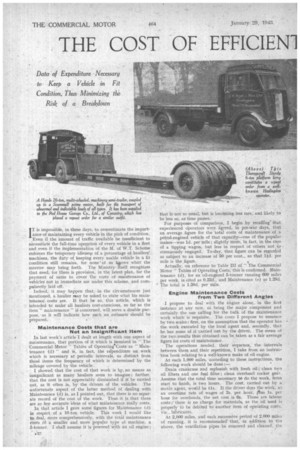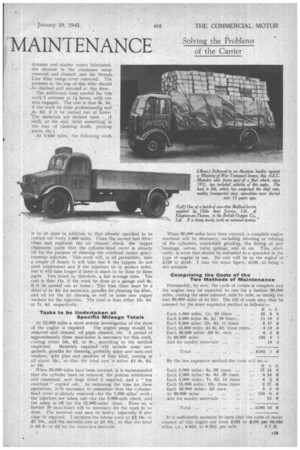THE COST OF EFFICIENT] MAINTENANCE
Page 24

Page 25

If you've noticed an error in this article please click here to report it so we can fix it.
Data of Expenditure Necessary to Keep a Vehicle in Fit Condition, Thus Minimizing the Risk of a Breakdown
IT is impossible, in these days,. to overestimate the importance of maintaining every vehicle in the pink of condition. Even if the amount of traffic available be insufficient to necessitate the full-time operation of every vehicle in a fleet and even if the implementation of the M. of W.T. Scheme enforces the temporary idlenees of a percentage of hauliers' machines, the duty of keeping every usable vehicle in a fit condition still remains, for none' of us kaows what the morrow may bring forth. The Ministry itself recognizes that need, for 'there is provision, in the latest plan, for the payment of sums to cover the casts of maintenance of vehicles' not in immediate use under this scheme, and com
pulsorily laid off. .
Indeed, it may happen that, in the circumstances just mentioned, a haulier nay be asked to state what his maintenance costs are. If that be so, this article, which is intended to make all hauliers cost-conscious, so far as the item " maintenance " i.4 concerned, will serve a double purpose, as it will indicate how such an estimate should be prepared. s Maintenance Costs that are Not an Insignificant Item
• In last week's article I dealt at length with one aspect of maintenance, that portion of it which is itemized in " The Commercial Motor " Tables of Operating*Costs as "Maintenance (d) " and is, in fact, the expenditure on work which is necessary at periodic intervals, as distinct from those items the frequency of which is determined by the mileage covered by the vehicle.
I showed that the cost of that work is hy, no means as insignificant as many hauliers seem to imagine ; further, that the cost is not appreciably diminished if it be carried out, as it often is, by the drivers of the vehicles. The unfortunate aspect of the latter method of dealing with Maintenance (d) is, as I pointed out, that there is no separate record of the cost of the work. Thus it is that there are so few accurate ideas of what maintenance really costs.
In that article I gave some figures for Maintenance (d) in respect of a 10-ton vehicle. This week -I would like to deal, more comprehensively, with the total maintenance costs cif• a smaller and more popular type of machine, a 5-tonner. I shall assume it is powered with an oil engine ; that is not so usual, but is becdming less rare, and likely to be less so, as time passes.
For purposes of comparison, I begin by recalling' that experienced oPerators were igreed, in pre-war days, that an average figure for the total costs of maintenance of a petrol-engined vehicle of that capacity—one of the popular makes—was id. per mile ; slightly more, in fact, in the care of a tipping wagon, but less in respect of others not so strenuously engaged. To-day, that figure can be regarded as subject to an increase Of 50 per cent., so that lid. per mile is the figure. e Actually, on reference to Table III of " The Commercial Motor" Tables of Operating Costs, this is confirmed. Maintenance (d), for an 'oil-engined 5-tonner running 600 miles per week, is cited as 0.22d„ and Maintenance (e) as 1.28d. The total is 1.50d. per mile.
Engine Maintenance Costs from Two Different Angles • I propose to deal with the engine alone, in the first instance at any rate, as being the major component and certainly the one calling for the bulk of the maintenance work which is requisite. The costs I propose to measure by two scales : first, on the assumption that the operator has the work executed by the local agent and, secondly, that he has some of it carried out by the driver. The mean of the two results thus obtained can he taken as a fair average figure for costs of maintenance.
The operations needed, their sequence, the intervals between them and their repetition, I take from an instruction book relating to a well-known make of oil engine.
At each 1,000 miles, according to these instructions, the following work should be done:— Drain crankcase and replenish with fresh oil ; clean two oil filters and one fuel filter; clean overhead rocker geir. Assiime that the total time necessary to do the work, from start to finish, is two hours. The cost, carried out by a mothr agent, woeld be I Is. If the driver does the work, a: an overtime rate of wages of 2s. per hour, plus 1s. per hour for overheads, the net cost is 6s. Those are labour costs ;' there is no charge for material*, as the .oil used is properly to be debited to another item of operating costs, viz . , lubricants.
At 2,000 miles, and each successive period of 2.000 miles of running, it is recommended' that, in addition to the above, the ventilation pipes be removed and cleaned, the dynamo and starter motor lubricated, the strainer in 'the crankcase sump removed and cleaned, and the Stream Line filter sump. cover removed. The pressure in the cup of this filter should -be checked and restored a': this time. The additional time needed for this work I estimate at 1 hours, with one man engaged. The cost is thus 8s. 3d. if the work be done professionally and 4s. 6d. if it be carried out at home.
The materials are debited later. (I shall, at the end, debit something in the way of cleaning stuffs, jointing paste, etc.) At 5,000 miles, the following work
is to be done in addition to that already specified to be carried out every 1,000 miles. Clean the second fuel filter; clean and replenish the air cleaner; check the tappet clearances (note tbat the cylinder-head cover is already off for the purpose of cleaning the overhead rocker gear); examine injectors. This work will, in all probability, take a couple of hours; it will take less if the tappets do not need adjustment and if the injectors be in perfect order, but it will take longer if there is much to be done to these parts. Two hours is, therefore, a fair average time. The cost is thus 1 Is. if the work be done at a garage and 6s. if sit be carried out at home.. This time there must be a debit of Is, 6d. for materials, paraffin for cleaning the filter, and oil for the air cleaner, as well as some new copper washers for the injectors. The total is thus either 12s. 6d. or 7s. 6d. respectively.
Tasks to be Undertaken at Specific Mileage Totals At 15.000 miles a more seridus investigation of the state of the engine is required. The engine sump should be removed and cleaned, oil pipes cleaned, etc. A period of approximately three man-hours is necessary for this work, costing either 16s. 6d. or 9s., . according to the method employed. Materials required will include some new gaskets, paraffin for cleaning„ probably some new nuts, and washers, split pins and sundries of that kind, costing in all about .10s., so that the total cost is either £1 ,6s. 6d. or 19s.
When 30,000 miles have been covered, it is recommended that the cylinder head be removed, the pistons withdrawn and examined, new rings fitted if required, and a " top overhaul " carried out. In reckoning the time for these operations, it is .necessary to remember that the cylinderhead cover is already removed—for the 1,000 Miles' work ; the injectors are taken out—for the 5,060-mile check, and the sump isoff for the 15,4100-miles' clean. Even so, a further 10 man-hours will be necessary for the work to be done. The material cost may be heavy, especially if new rings be required. I estimate the labour costs at £2 15s. or Al 10s., and the material cost at £3 10s., so that the total is £6 5s. or £5 for the respective methods.
When 60,000 miles have been covered, a complete engine overhaul will be necessary, including reboring or relining of the cylinders, crankshaft grinding. .the fitting of new -bearings, valves, valve springs, and so on. This, obviously, is work that should be entrusted to a specialist in the type of engine in use. Its cost will be in the region' of £120 to £140. I take the mean figure, £130. as being a fair estimate
Comprising the Costs of the Two Methods of Maintenance Presumably, by now, the cycle of events is complete and the engine may be expected to run for a further 60,000 miles, costing the same amount', mile by mile, as duritig the fast 60,000 miles of its life'. The bill of costs may thus be assessed for the more expensive method as follows:— It is sufficiently accurate to state that the costs of maim: tenance of this engine are from £165 to £190 per 60,000 ' miles. i.e., 0.66d. to 0.76d. per mile. S.T.R.




















































